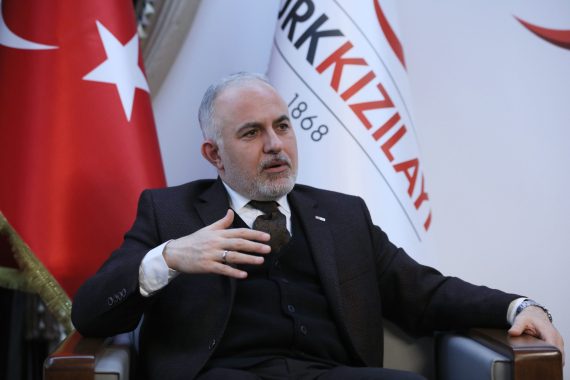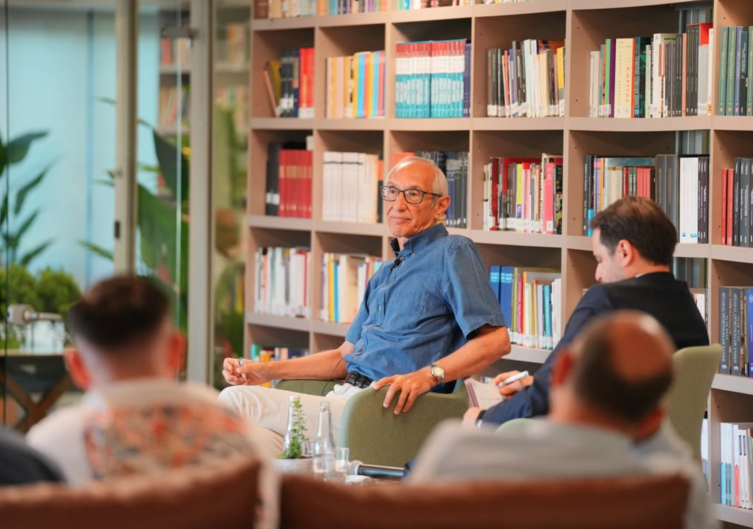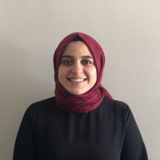Who is Kerem Kinik? What was your background before becoming the President of Kızılay (the Turkish Red Crescent)?
KK: Kerem Kinik is a doctor of medicine. I did not practice my profession in clinics that much but rather gained experience in management positions in the Istanbul Metropolitan Municipality and several other private companies. Then, my path crossed with humanitarian aid. This process actually began during my years at university. However, Yeryuzu Doktorlari was an important turning point. My story in this sector began with voluntary works. In 2015, I was elected as a board member with an extraordinary congress and then elected as president in 2016. I am also currently working at Bezmialem University as an instructor at the Health Sciences Institute. I am conducting my job at Kızılay with all my heart and soul. My wife is a dentist, we have three children – whom I’m able to see once every 2 to 3 months.
How do you think the transformation of Turkey’s foreign policy over the past 15 years has affected Turkey’s humanitarian aid policies and what kind of reflection does this have on the works of Kızılay?
KK: As of the early 2000s, Turkey achieved growth, improvement, expansion and new initiatives in every sector, ranging from academia, industry, trade, and civil society. This demonstrates Turkey’s ambition to consolidate its power in a way to encompass both the state and the nation. This ambition reverberates on everything, including statistics. So, there is growth in every indicator such as our activities, per capita income, the number of associations, and the number of countries where we engage in activities.
In fact, it would be more accurate to call it the realization of a potential rather than a growth, since we have come here from a land 40 million square kilometers away. So, we left our brothers and sisters and relatives there. Especially during the times when Turkey adopted introverted policies, such as the junta periods following the coups and memorandums in 1960, 1971, 1980 and 1997, our freedom of thought was restricted and we were forced to memorize a set of biased stereotypes such as “Turkey is a country surrounded by seas on three sides, and by enemies on four sides” and “The Turk has no friend but the Turk.” This was in fact the part of a design that aimed to downplay and undermine Turkey’s potential.
Of course, the nation has always normalized the political arena with a groundswell; so, the period starting from the 2000s is the continuation of this. The traces of these problems have always been confronted, especially during the changes in the trade system after the industrial revolution, the recessions in the defense industry, the emergence of a nation-state model in governance, and the dissolution of empires.
As a resilient society, our people have always been in search of a model to keep standing. We have experienced such quests particularly during the periods of Adnan Menderes, Turgut Ozal, Necmettin Erbakan, and finally our current President Recep Tayyip Erdogan. The groundswell of our nation prevails in every sphere of life, so our nation wants to engage in more activities of aid. They want to help more people, engage more in trade and production.
When did international aid organizations in Turkey actually gain a legal ground to operate internationally?
KK: I clearly remember the years of 1992 and 1993. During the collapse of Yugoslavia, we strived to provide aid to the region, including Bosnia and Kosovo, but transferring aid out of the country’s borders was forbidden. There was a circular issued by the Prime Ministry during late Ecevit’s term that banned NGOs from directly transferring aid out of Turkey and urged that aid could only be transferred though the channel of the state. For this reason, IHH Humanitarian Relief Foundation was founded in Germany whereas Yeryüzü Doktorları was founded in Britain.
The organizations seeking to engage in international activities did not find a relative legislation in Turkey. Eventually, during the period of the AK Party, the aid law was amended. The positive changes on the laws caused a boost in civil society activities. Of course, aid activities were always maintained through alternative and mostly unofficial ways. For example, I transferred 30 trucks of disaster relief material to Kosovo during the civil war. But we did it under the guise of a trade activity. We paid the customs cost through a company, went to Skopje and loaded the material, presenting the material as a commercial commodity. Then we went on and distributed them in Kosovo as if engaging in export – all due to the legislative restrictions.
Consequently, the reformation of some paths pursued in Turkish foreign policy reverberated on our international aid activities while the demilitarization moves of Turkey eased the organization of civilian space and the removal of the pressures on the structures created new structures in which society can have better self-expression and organization means and gained dynamism. Of course, they all positively affected the general picture.
During the collapse of Yugoslavia, we strived to provide aid to the region, including Bosnia and Kosovo, but transferring aid out of the country’s borders was forbidden. There was a circular issued by the Prime Ministry during late Ecevit’s term that banned NGOs from directly transferring aid out of Turkey and urged that aid could only be transferred though the channel of the state
How did Kızılay grow over the past 15 years?
KK: As a resilient and self-renewing institution, Kızılay has kept standing for its 150 years of history despite all difficulties. So, we can talk about an organizational culture. Kızılay faced some weaknesses especially during the devastating 1999 Marmara Earthquake.
We occasionally conduct social research. People must note that Kızılay is no longer the Kızılay of 1999. The institution is still judged on the basis of the conditions in 1999. In fact, Kızılay is held accountable for the cost of losses in the earthquake to some extent. But back then, the state used to have a great deal of problems. And Kızılay was one of the best institutions among others.
So, the self-criticism process that started with the 1999 Earthquake is still ongoing in the institution. While part of Kızılay deals with humanitarian aid and some technicalities relating to this, there is a part in the organizational structure influenced by the 1980 military coup and its aftermath. Despite that, the institution made considerable progress in certain fields, such as the disaster relief and blood donation. The regulatory changes in 2009 contributed to this change. But it was not sufficient for the transformation and improvement of Kızılay.
Kızılay has now revised its 630 business processes one by one, reformulated its duties, vision and national statement, and clearly defined society’s expectations from the institution and where the institution sees itself in the next 20 to 30 years.
The present operational size of the institution has been designed with the planning, restructuring and institutional enhancement processes that began after 2015, and the implementation stage of the process is still ongoing. Therefore, in a period where the state has been restructuring itself, Kızılay has remodeled all its business processes. It has revised its 630 business processes one by one, reformulated its duties, vision and national statement, and clearly defined society’s expectations from the institution and where the institution sees itself in the next 20 to 30 years. Kızılay is more than an institution. It is a dynamic movement with its volunteers and donators.
As the Syrian crisis is extremely profound, it created an operational burden for us and we had to change our plans and activities in consideration of this. There are 4 million refugees, and most of their social integration and humanitarian aid activities have been shouldered by Kızılay. We also take care of the refugees inside the country and some additional burden at the zones of armed conflict. So, Kızılay has reassigned its position according to the new world, the new problems and the new duties thorough strategic mapping and planning. The institution continues its efforts in a planned and determined way.
There are 4 million refugees, and most of their social integration and humanitarian aid activities have been shouldered by Kızılay. We also take care of the refugees inside the country and some additional burden at the zones of armed conflict.
Can you give us some information on Kızılay (the Turkish Red Crescent) Community Centers?
KK: We firstly formed a unit of immigration services, which has two main duties; the first one is to support the newly-arrived immigrants in Turkey. Secondly, the number of people who had to leave their homes due to the 40 active wars around the world has reached around 68.6 million. Think about the Rohingya people in Rakhine and internally displaced people in Syria, for example. We dealt with the question of how we could help them.
What do you provide them?
KK: We provide a wide range of services. These include providing refugees with humanitarian aid during migration, and with protection and humanitarian diplomacy services for the protection of refugee rights. Especially in Syria, we have contributed to three major rescue operations and managed evacuation processes. One of them was the process of evacuating 40 thousand people from the sieged Aleppo, the second one was the evacuation of 108 thousand people from Homs region. The third and the biggest one is the evacuation process of around 150 thousand people from Eastern Ghouta. So, we managed all these processes by maintaining negotiations in the field and ensuring the security of civilians at these spots.
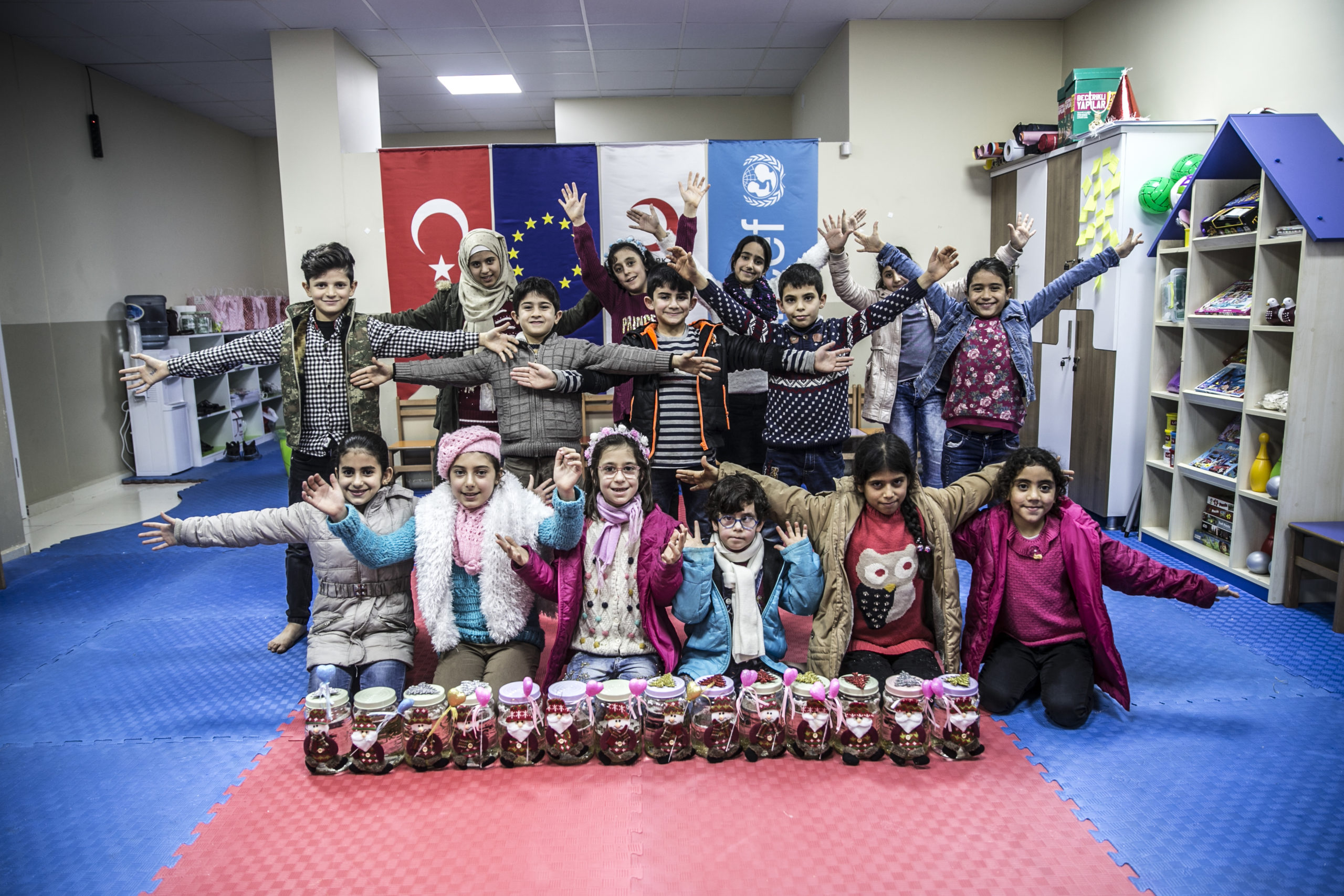 Syrian children at a community center in Hatay, Turkey.
Syrian children at a community center in Hatay, Turkey.
Community centers provide services with regard to social integration. We have some preventive works to avert possible tensions between the host and refugee communities. We inform them on the rules and civic duties of the society they have come to with a focus on their reason for immigration. We also provide information on legal procedures, employment and education in the country. We also exert efforts to present new jobs to the people aggrieved and traumatized by the war.
We introduce them to a set of social entrepreneurship means in Turkey to teach them language and encourage their employment. We also engage in psychological and social assistance efforts to address the problems of those aggrieved by war and immigration – especially children. This is an extensive program conducted in all camps in Turkey, our community centers and our mobile trucks.
The centers also try to protect peace between the communities by preventing biases and misinformation. We have tracking systems at such spots. When a Syrian is subjected to an unjust practice, or confronts a problem that cannot be resolved, s/he consults us and we defend their rights to the relevant units. Consequently, community centers have been accepted as units that protect human rights and support refugees’ positions in society by making sure that they live in proper health conditions and in line with human dignity. The centers have become widespread lately.
When a Syrian is subjected to an unjust practice, or confronts a problem that cannot be resolved, s/he consults us and we defend their rights to the relevant units.
Will the number of these centers increase?
KK: Yes, definitely. In fact, community centers serve for community resilience and endeavor to prevent the deprivations in extraordinary situations such as natural disasters and poverty. We aspire to address our own citizens as well to strengthen society as a whole. In this sense, we are launching a new one in Cizre for the first time for a different target audience. Large masses are aggrieved by terror in Cizre, where 80 percent of the population consists of the youth while the number of children is around 50 thousand. So, there is serious need for guidance considering the young population. There are no jobs, financial difficulties are prevalent. The city is neglected and disorderly due to the ditches dug by terrorists. It offers no chance of socialization, no promise. Of course, it was a different place in the past. We have a community empowerment program addressing the region. And we will open a community center in support of this.
Recommended
Do you think there are any differences in opinion between Turkey and other states in terms of humanitarian aid? As this concept is also considered a market of its own, where does Turkey position itself within this market?
KK: Humanitarian aid has some global-scale problems. Today, we are confronted with major crises stemming from the fact that the system formed after World War II can no longer address the current problems. All the mechanisms created for the prevention of wars and the regional pacts authorized to use force such as the UN General Assembly have turned into mechanisms that deepen and exacerbate the already existing conflicts. Consequently, a mandate is required after the mechanism issues a decision. When a mandate is not implemented, states and their leaders take courage. For instance, there are 300 decisions issued against Israel’s breach of international law and violations of human rights, but none of them have been practiced so far. This situation harms the belief in justice. For instance, the Syrian crisis persisted after the use of chemical weapons by making use of the gaps within the system, which is unacceptable.
As can be remembered, around 1000 children died due to chemical weapons, upon which the U.S. said that this crossed their red lines. But when the regime said that they wanted to cooperate and destroy the chemical weapons, everyone stopped. The war stopped and [the regime] impeded all the possible interventions for over a year and took some extra measures in the meantime. After that, they used chemical weapons again on numerous occasions. So, the insolubility of the international system stems from the armed conflicts and climate change.
I would rather refer to the current concept of urbanization across the world as the “ruralization of urban” people because most people migrating to cities live in slums and squatter houses as their integration process to the urban culture fails.
The second one poses a greater threat to humanity, considering all the impoverishment, migration moves and wars caused by climate change. For instance, in Africa’s Darfur region, an issue caused by the problem of barrens and grasslands between the local Arab farmers and nomad Arab tribes evolved into a complicated problem. The factors that triggered this issue are actually linked to the new livelihood and production dynamics caused by global climate change. Thus, climate change stands before us as one of the biggest challenges along with the armed conflicts.
I would rather refer to the current concept of urbanization across the world as the “ruralization of urban” people because most people migrating to cities live in slums and squatter houses as their integration process to the urban culture fails. They are vulnerable to all criminal activities, the political stabilization in the world has been suffering a crisis, and pacts are not relevant to today’s world while states have come up with the formula of proxy wars. States are currently fighting each other by means of giving support to certain terror groups, which has lower costs and prevents any direct harm to the state. Civilians suffer a great deal due to this. According to a UN report, 72 percent of the people killed or injured due to bomb blasts or armed conflicts are civilians. This rate climbs up to 90 percent in rural areas.
All the mechanisms created for the prevention of wars and the regional pacts authorized to use force such as the UN General Assembly have turned into mechanisms that deepen and exacerbate the already existing conflicts.
What does this mean then?
KK: This means that the system cannot protect civilians. Also think about the unequal income distribution and poverty. 1.5 billion people around the world live on less than 1.2 dollars a day. Around 900 million people go to sleep hungry every night. One billion people do not have access to clean water. Around 6 million children aged between 0-5 die from preventable causes, while half of them die from starvation. More than 300 thousand women die from causes related to pregnancy or childbirth. More than one million people die from malaria every year. Amid such tremendous fatalities, the money spent on humanitarian aid is less than 100 billion dollars while around 1.79 trillion dollars is spent in the defense industry.
Around 900 million people go to sleep hungry every night. One billion people do not have access to clean water. Around 6 million children aged between 0-5 die from preventable causes, while half of them die from starvation.
The funds allocated by the UN is around 30 billion dollars, and 40 percent of that comprises the coverage ratio of calls. The ratio of meeting the funds is low but there is a giant mechanism active, including vehicles, personnel, business flights and such. A large proportion of the money collected is spent on the management of these. But to what extent do they quell the human suffering? So, the humanitarian aid sector has a serious problem of funding and certainly needs a reform. The previous reform occurred in 2005, of which grounds were laid by the UN. A coordination mindset was introduced and OCHA was established. Humanitarian aid offices were formed. Areas of specialization were introduced and clusters were formed. Service areas were created in many fields such as nutrition, help, livelihood, and protection.
Also, service clusters were formed and distributed to agencies. So, a fair and sustainable funding system was created. This mechanism was successful to some extent. Especially the post-2000 millennium development goal was the greatest humanitarian initiative of people. It accomplished many things in this sense. But at this point today, this mechanism does no longer work and remains unable to strengthen the local actors. There is only a league of giants, including UN agencies and international NGOs. Their funds are secured and their operations are large-scaled. The smaller organizations shoulder the main responsibilities and conduct the operations but the funds are only distributed among the giants. This system must be reformed. As Kızılay, we are of course a part of this structure. There are three main lines in the humanitarian aid sector: The UN, NGOs, and the International Red Cross and Red Crescent Movement. We are within the third line, in Red Crescent Societies.
We have a federation, through which we carry out our joint operations within the UN. National associations have their own works and efforts in this scope. So, we can say that the humanitarian aid sector needs a set of global-scale structural reforms. The aid models need to be changed. They must address the root causes of poverty and deprivations and offer solutions to them. Providing food or clothes does not wipe poverty out. The poor will need these materials again after consuming. So, as Kızılay, we are kicking off a large initiative in the Şırnak and Hakkari provinces of Turkey, which we call “cheer-up program.” Within this project, we aim to address the root causes of poverty and engage in efforts to remove these causes. In these two provinces, our first target group will be women.
We will provide women with various social entrepreneurship opportunities that will enable them to contribute to household income with avocational practices. We will provide micro-entrepreneurship support. We will also give them entrepreneurship training and mentorship. They have a number of immediate needs. For example, they cannot go to school, some of them need scholarships, some of their houses are not very favorable for a healthy living, and some of them suffer from hunger. By draining the swamp in a collective manner and providing them with social entrepreneurship opportunities, we will endeavor to empower them. And when we determine and set up our new model, we will present new means of social business within Turkey as we have been contacting Bangladeshi social entrepreneur Muhammad Yunus and Islamic Development Bank about giant international finance models.
This needs to be applied across the world, too. Cash support is gradually taking the place of in-kind donation. As Kızılay, we are undertaking the biggest cash mission of the world in Turkey. We provide 17 million refugees from 68 different origins, most of whom are of Syrian origin, with cash support via the Kızılaykart. This is the world’s biggest and most widespread program and funded by the end of 2020. In this sense, we are working together, which ensures the protection of refugees’ human dignity. They can purchase their needs through credit cards, which invigorates and contributes to the local economy. This is a more sustainable model with lower costs. So we endeavor to disseminate it. This is also one of the models we are currently working on for Yemen. If people have money in some way, the traders bring the commodity to the region. Only purchasing power is needed for that.
How was the Kızılay Academy established?
KK: We had friends working in this academy and had small-scale incubation centers. So, they started to overlap. But what we really wanted to focus on was the three missions of Kızılay, namely disaster relief, humanitarian aid, and social contribution. An academic platform was needed for research and development activities, academic career or institutional research centers in these fields. One of the leading problems we confront in our sector in Turkey is the lack of academic interest. As the ones operating in field, we are trying to help with everything directly by ourselves. Is the model we developed applicable? What is its social impact? Can a more different model be created? What does it represent in public opinion? Such endless questions can be directed by scientists. But no one asks such questions today. And those asking them do not seem too familiar with the realities of the field.
I am also a PhD candidate studying on the encounters of Syrian refugees in Turkey to Turkey’s health system and how the system operates and renews itself. There are many aspects to focus on such as costs, security aspect, and the question of whether they were provided services in the same spaces as the locals. I receive the data and upload it to the database, and wrote a program for that. Then we sent a query. It is actually a very promising area for academic studies. But still, no one asks relevant questions. As much as I am an academic, I am also active in the field. And I can see that there are many blind spots that need to be illuminated in terms of immigration, poverty, disaster consciousness and preparation.
An academic platform was needed for the research and development, of the three missions of Kızılay, namely, disaster relief, humanitarian aid, and social contribution.
We want to shed light on all these points. Also, we want to encourage research on these subjects and allocate funds to them. There will also be an inventory academy, which will not only serve our citizens. In this sense, this will be a center for creating human resources necessary for the humanitarian aid sector. Likewise, we have made agreements with the Islamic Development Bank and Organization of Islamic Cooperation. They will also recognize this place as a civil society center for the relief of the problems persisting in the Islamic world. And we also have many implementations such as practical schools, through which we will meet our need for human resources.
Within the Kızılay Academy, we have efforts on non-formal and continuous education alongside academic research activities. We are creating an open learning platform. We will share the contents of our training with citizens in view of a certain disciplines and they will receive certificates after training. We have been making planning, taking steps and designing sources for these activities and we have been designing all of these since 2015. We also have Kızılay Arts and Kızılay Sports. Especially Kızılay Sports endeavors the integration of disadvantaged groups into society. We want to encourage the youth to adopt a culture of leading a healthier life while presenting various opportunities to enable the peaceful co-existence of refugees and locals. These are only a few of the numerous baby steps we are taking, which will hopefully yield results.
Is there any moment that specifically affected you during your field experience?
KK: I get this question a lot, but it is hard to answer this since we endeavor to meet the needs of people and support them in most difficult situations. Since we confront large-scale problems most of the time, we unfortunately cannot pay attention to individual cases. For instance, in the Ghouta evacuation, people lived in the basements of apartment buildings and eat only one meal a day if they are lucky enough to find food while the region was sieged for around six years and barrel bombs and artillery shootings became a part of everyday life.
Most babies born at that time suffered from disorders in bone development due to the vitamin D deficiency. It was a painful case. There were 400.000 aggrieved people. As the pressures increased, people of Ghouta suffered growing numbers of civilian casualties. The average number of people killed within a day was around 150-200. At the time, some names became symbols in Ghouta, including children such as the baby Karim. Karim lost one of his eyes due to an attack by the regime. His mum died there and then.
People of Ghouta suffered growing numbers of civilian casualties. The average number of people killed within a day was around 150-200. At the time, some names became symbols in Ghouta, including children such as the baby Karim. Karim lost one of his eyes due to an attack by the regime. His mum died there and then.
We tried to get him out of the region for his treatment but it was not allowed and a bribe was asked for. They bribed us for getting the child out of Ghouta, so we couldn’t. Since the child got injured, we immediately sent our teams to the region. We already had teams in Ghouta and were providing food aid regularly. This was reminiscent of the siege of Bosnia. We tried to help Karim as much as we could. He survived despite losing his eye and half of his head, and recovered on his own. Maybe you can remember the photos showing him smiling in that condition. Another bomb hit his house, and his father and brother were injured while his sister was killed. During the evacuation, his brother was abducted to Damascus. We located where he is and we are now trying to reunite Karim’s family.
Such children, including Karim, Qasim, Noor and Alaa, have turned into symbols. All the reports we wrote on the Ghouta issue were not as nearly effective as one photo of Karim, just as the Aylan Kurdi case. But the recognition of these children constitutes a threat since they might be abducted for ransom. While we were waiting on the Idlib-Hama border during the Ghouta evacuation and meeting the arrivers, we sent a message for the prevention of Karim and Qasim’s abduction. We also communicated with Noor and Alaa sisters through Twitter and they informed us on their location. But unfortunately, the three of them were kidnapped by people who approached them by saying they wanted to offer help. Someone said that those abducting Karim were going to Aleppo with a minibus. We sent a unit to trace and follow them since it was a dangerous road. When they stopped for gas, our unit intervened and saved the child.
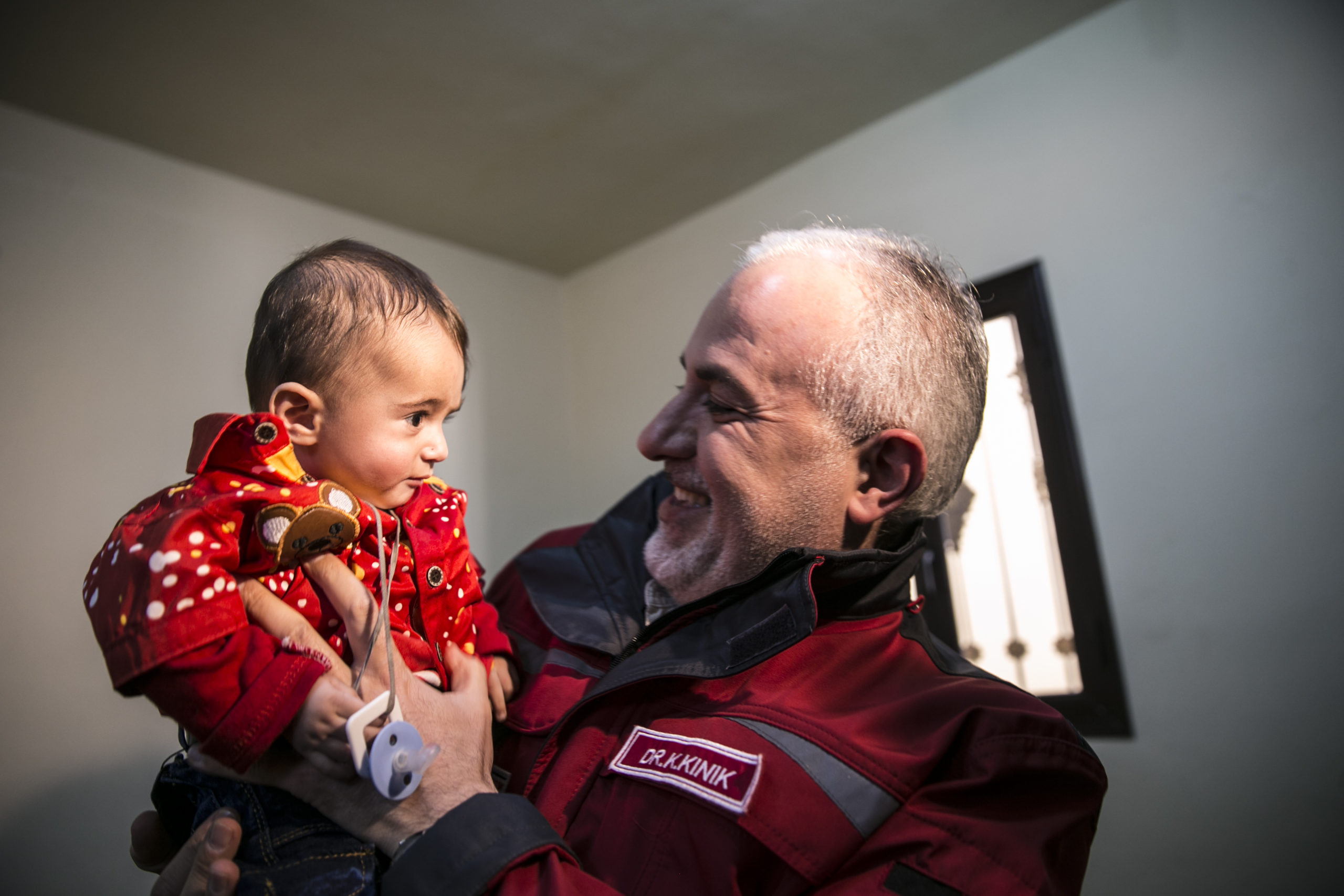 Kerem Kinik holds Syrian baby Kerim, who lost his mother along with his eye during an assault of Assad Regime, after he was brought from besieged Eastern Ghouta to Turkey’s Hatay in April 01, 2018. Anadolu Agency
Kerem Kinik holds Syrian baby Kerim, who lost his mother along with his eye during an assault of Assad Regime, after he was brought from besieged Eastern Ghouta to Turkey’s Hatay in April 01, 2018. Anadolu Agency
They also saved Qasim from a similar case. Noor and Alaa were brought to a region on the Idlib-Darkush border. Noor reached to me and said that they were in a house with a group of armed men. When we asked about her location, she said that she did not know the location but described a river flowing nearby. According to her description, we could find their location and took back the children with the help of a unit. They are only a few people I get to know personally, but around 150.000 people came from Ghouta. So, there must be 150.000 different stories. When you reach out and speak to them, you find tragic stories in every encounter that would easily inspire a Hollywood movie. So, we try to throw as many starfishes as possible into the sea. This is our story.
*This interview was conducted on 20 November, 2018.
